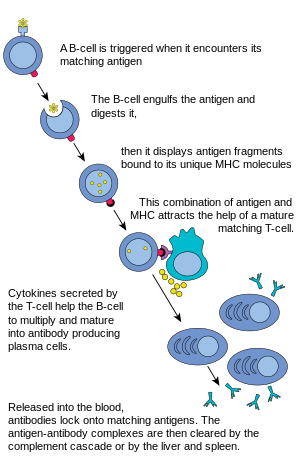 B cell activation
B cell activation
B cells are lymphocytes, a type of white blood cell. Once the B cell is activated, it turns into a plasma cell,[a] and starts producing antibodies. They are a vital part of the adaptive immune system. They have a protein on the B cell's outer surface known as a 'B cell receptor'. This allows a B cell to bind to a specific antigen.
The main functions of B cells are:
- to make antibodies against antigens,
- to perform the role of antigen-presenting cells (APCs),
- to develop into memory B cells after activation by antigen interaction.
Recently, a new, suppressive function of B cells has been discovered.[1]
In mammals, immature B cells are formed in the bone marrow, hence their name.[2]
Note
- ↑ Plasma cell = cell which makes antibodies
References
Other websites